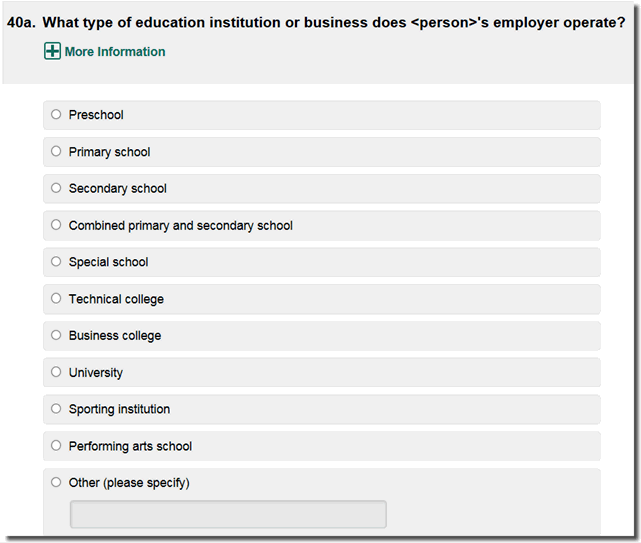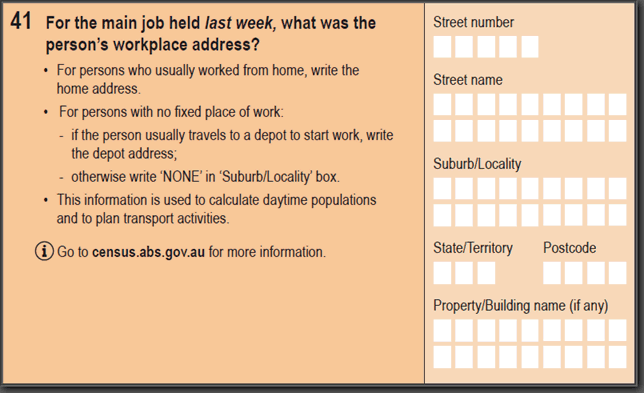Industry of Employment (INDP)
This variable describes the industry in which employed people work. This variable is applicable to all employed persons aged 15 years or older.
The Census is designed as a snapshot of detailed information every 5 years. Changes are sometimes made to how the data is collected between Censuses. This page outlines a number of changes to how Industry of employment information was collected for the 2016 Census, including the implementation of targeted supplementary questions. Users should note that changes introduced for the 2016 Census mean that this data is not directly comparable to the previous Census Industry of employment data. The Labour Force Survey (cat. no. 6202.0) and the Labour Account (cat. no. 6150.0) are statistical collections designed to measure movements over time in industry, occupation and employment data for Australian workers. See The 2016 Census and the Labour Force Survey for further information on how to use these data sources for analysis and decision making.
How the variable is created
Industry of Employment is a person variable and is created based on write-in responses to four questions on the Census form. Images of these questions are provided below and include:
- The business name
- The address of a person's employer
- The type of industry
- The main goods or services produced by the business or their employer
Industry of Employment is coded to the
Australian and New Zealand Standards Industrial Classification (ANZSIC), 2006 (Revision 2.0).
To code the information, industry of employment is first obtained by matching business name and address responses to ABS lists of business names for which main industry activity is already known. The remaining responses are coded using write-in responses about type of industry and about main goods or services produced.
Industry coding is reliant on a variety of processes. All write-in responses for paper and online forms that contribute to industry coding are first auto-repaired before being sent through two autocoding indexes: the Groomed Business Name Index (GBNI) and the Activity index. These text repair and automatic coding process resulted in approximately 86.2% of all responses being coded automatically. The remaining 13.8% of records that did not successfully achieve a code in autocoding were examined by ABS clerical staff and independently assessed for an ANZSIC code.
Responses with insufficient information to assign an ANZSIC code are coded to 'Inadequately described'.
Variable history
The questions relating to Industry of Employment or similar were first asked in the 1911 Census and have been asked in all censuses since then. There were no changes to three of the four main questions used to to derive ANZSIC codes (i.e. questions 40, 41 and 43), though some changes were made to the examples used for question 43. The type of industry question (question 42 (paper form) and question 40 (online form) ) was changed from having a combination of mark box and write-in responses to just being write-in.
Targeted supplementary questions (TSQs)
For online 2016 Census forms, the coding approach was different to paper forms for industry of employment responses. Targeted Supplementary Questions (TSQs) were introduced in the 2016 online forms to clarify responses for Industry and facilitate more accurate coding at the lower levels of the classifications. TSQs, which are prompted by 'trigger words' entered by the respondent, are predefined radio button questions which collect more details about industry from the respondent in addition to the response they initially provided. For example, if the word 'education' was entered as the industry or business of the employer for which the respondent works, then extra questions are asked about what type of education institution or business does the respondent's employer operate, i.e. Preschool, Primary school, Secondary school, Combined primary and secondary school, Special school, Technical college, Business college, University, Sporting institution, Performing arts school or Other (please specify).
The list of 'trigger words' and targeted supplementary questions was created by looking at common responses in the 'not further defined' coding categories from the 2011 Census data. 'Not further defined' category is used when there is insufficient information to code the response to a detailed category in the classification. A response of 'education' for example is not enough to code to a detailed industry such as Preschool or University and would be coded to the 'Education and Training, not further defined' category.

A text only version of the online Census Household form is available from the Downloads tab and pages 33-40 include the Industry targeted supplementary questions.
Responses to targeted supplementary questions were coded without running them through the Groomed Business Name Index (GBNI). This is the only circumstance in the Industry coding where the Business Name response (if provided by the respondent) did not take priority over the other data fields.
Non-response rate
Unlike most Census variables, the non-response rate for Industry of Employment is not affected by persons who did not return a Census form because this variable is only applicable to persons with a labour force status of 'employed'. For more information, refer to Understanding Census data quality.
The non-response rate for this variable was 1.2% (1.1% in 2011).
Data usage notes
There have been impacts to the data from including targeted supplementary questions for the online Census form.
Decrease in not further defined counts for some industries
The 2011 Census form included check box options that respondents could mark and the instructions included examples of what falls in the 'Other - please specify' text box option.
With a write-in response option instead for 2016, 17.1% of all online responses (excluding 'other - please specify' responses) were coded to an ANZSIC category via the use of targeted supplementary questions. The targeted supplementary questions captured more detail at the ANZSIC classification 4 digit level, which helped reduce the 'not further defined' counts for 2016.
Alignment with 2011 Census high level industry mark-box options
Not all 2016 high-level industry categories were associated with targeted supplementary questions. Manufacturing, Wholesale and Community Service, which were mark boxes in the 2011 Census form, were not associated with any targeted supplementary questions. This highlights how different industries will be impacted unevenly by the use of targeted supplementary questions.
| 2011 Industry/Business check box options | 2016 Trigger words for targeted supplementary questions |
|
| Manufacturing | not applicable |
|
| Wholesaling | not applicable |
 |
| Retailing | 'Retail, Retailing, Retailer, Retail store, Retail sales' |
|
| Accommodation | Hospitality'
'Tourism' |
|
| Cafe, restaurants and take-aways | 'Hospitality' |
|
| Road freight transport | 'Transport, Transportation, Driving' |
|
| House construction | 'Construction, Building, Building construction, Building and construction' |
|
| Health service | 'Health, Health care, Healthcare, Health service, Health services' |
|
| Community care service | not applicable |
|
| Other - please specify |  |
|
For the removed mark boxes in the 2016 online form, the possible impacts are outlined below:
- where the 2011 tick box was more general, there was a decrease in the 'not further defined' codes and an increase in detailed codes which is an improvement (e.g. Health).
- where the 2011 tick box was detailed, i.e. house construction (code 3011) and road freight transportation (code 4610), the decrease in these codes is significant and so are the increases in the related 'not further defined' codes.
- where there was not a targeted supplementary module with trigger words similar to the tick box that was removed, there were large drops in related 'not further defined' categories and some detailed codes.
- the addition of targeted supplementary questions to the online Census form helped improve coding for some industries, however there was also an overall increase in the proportion of responses that were 'Inadequately described' (which could not be coded or could only be coded with reduced detail) compared to 2011. The increase in inadequately described responses was also observed for paper forms. For 2016, counts of responses that were inadequately described comprised 3.2% of the data (compared to 1.2% in 2011).
Further information
A definition of Industry is available in the
2016 Census Dictionary.
For information related to Industry, see data quality statements for
Labour Force Status, Public/Private Sector and
Occupation.
Household form question image
Questions 40, 41, 42 and 43 as they appear on the 2016 Census Household Paper Form:




A text only version of the online Census Household form is available from the Downloads tab.
 Print Page
Print Page
 Print All
Print All